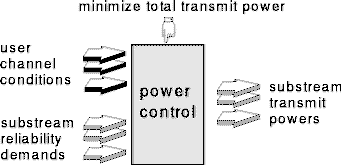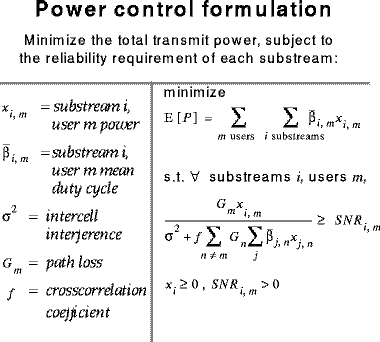
Power Control for Cellular Systems
Contributed by Louis Yun, U.C. Berkeley
What's It Used for?
Power control can substantially impact the capacity and perceived
quality in cellular wireless systems. Regardless of
the mode of multiple access --
be it frequency, time
or code division
-- power control is necessary to combat the intercell, or co-channel,
interference that arises from frequency reuse.
Additionally, power
control is employed to minimize the intra-cell interference in direct
sequence code division multiple access (DS-CDMA) systems.
On an ideal channel, it is possible to maintain code
orthogonality among all users of the same cell.
Unhappily, a wireless
channel introduces multipath,
so this perfect code
orthogonality is destroyed and the user experiences intracell interference.
Power control is particularly crucial on the DS-CDMA uplink: with
out it, the signal of a mobile at the cell periphery would be drowned
out by an interfering mobile situated close to the base station.
Furthermore, on the DS-CDMA uplink the code waveforms of different
users arrive at the receiver unsynchronized with one another.
Unless the receiver performs code resynchronization, the interference
is heightened, exacerbating this "near-far" problem and increasing
the need for power control.
Intracell interference can affect
TDMA and FDMA systems as well, in the form of adjacent channel
interference; for example, practical bandpass filters cannot perfectly
reject adjacent frequencies, matched filters may not always
sample over the correct intervals, and multipath can cause
intersymbol interference across different users. This need for power
control in cellular systems to combat interference has been recognized
and is the subject of much research (see references).
Current Approaches
Present day power-control algorithms attempt to counter interference
via one of the following:
- maintaining constant received signal power
- uses negative feedback from receiver to transmitter
to keep the received
power at a constant level
- PRO: very efficient in controlling intracell interference
- CON: has limited effect on intercell interference
- performing carrier-to-interference ratio (CIR) balancing.
- the measure of quality here is the carrier-to-interference ratio
- allocate power to each user such that all users experience the
same CIR
|

Louis Yun covering power control algorithms in a short course.
|
Recent Advances
Recent advances in power control have been motivated by
the next-generation PCS systems, in particular the vision
of wireless multimedia, as for instance address in the Infopad research project.
Multimedia adds a new dimension
of complexity to system design, since different types of
media - video, audio, data - have different reliability
requirements.
Question: how do we support the diverse needs of heterogeneous
traffic and still maintain high throughput in a wireless system?
New Ideas and Answers
- it is possible to simultaneously satisfy different reliability
needs of different traffic and minimize interference through power
control

- to gain efficiency: perform joint-source-channel coding by breaking
source traffic into substreams, each substream with its own quality of
service requirement
- the network can then assign more resources (power, bandwidth) to
substreams of greater importance
- combine the strengths of power control and channel coding together
for unequal error protection
- exploit fixed-rate coder for high coding gain
- use power control to provide unequal error protection

 References
References
-
 L. Yun and D. Messerschmitt, "Variable QOS in CDMA systems by statistical
power control," Proc. IEEE ICC, Seattle, WA, June 18-22, 1995.
L. Yun and D. Messerschmitt, "Variable QOS in CDMA systems by statistical
power control," Proc. IEEE ICC, Seattle, WA, June 18-22, 1995.
-
 L. Yun and D. Messerschmitt, "Power control and coding for variable
quality of service on a CDMA channel," Proc. IEEE MILCOM Conf.,
Fort Monmouth, NJ, Oct 2-5, 1994, pp. 178- 182.
L. Yun and D. Messerschmitt, "Power control and coding for variable
quality of service on a CDMA channel," Proc. IEEE MILCOM Conf.,
Fort Monmouth, NJ, Oct 2-5, 1994, pp. 178- 182.
- L. Yun and D. Messerschmitt, "Power control for variable quality
of service in cellular systems," in preparation.
- J. Zander, "Performance of optimum transmitter power control in cellular
radio systems," IEEE Trans. Vehicular Tech., vol. 41, no. 1, pp. 57-62,
Feb 1992.
- M. Mokhtar and S. Gupta, "Power control considerations for DS/CDMA
personal communication systems," IEEE Trans. Veh. Tech., Vol. 41, No. 4, pp.
479-487, Nov. 1992.
- QUALCOMM Inc., "Compatibility standard for dual-mode wideband
spread spectrum cellular system," TIA/EIA/IS-95, July 1993.










 References
References